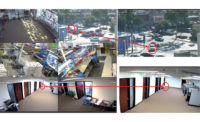While most people already know this, there may be some who haven’t yet learned one of the most absolute truths for dealers and integrators in the security industry: recurring monthly revenue (RMR) is the key to success. In the near term, a steady stream of predictable monthly revenue grows profits and makes it easier to plan for expenses like labor and equipment. In the future, if and when a business is sold, its valuation will be based on a multiple of that RMR.
The best way to grow this all-important factor is through services, primarily ongoing maintenance contracts to ensure customers’ systems continue to function properly, and central station monitoring to provide law enforcement response to alarms if needed. However, in addition to alarm response there are any number of add-on services that bring greater value to end users’ systems.
One of these add-on services that is among the most ripe for growing RMR is in the video space Alarm verification is probably the most obvious of these services, but the capabilities of today’s IP surveillance cameras, coupled with the high-quality images they generate, has opened doors to a wide variety of video-related services, each of which can be added individually or in bundles to increase the monthly fee end users pay. And because video has become so prevalent in our everyday lives, many customers are not only willing to pay for any or all of these services, but they’ve more or less come to expect advanced video capabilities.
“I think there is some real opportunity in the traditional alarm monitoring space,” says Morgan Hertel, vice president of technology for Syracuse, N.Y.-based Rapid Response Monitoring. “Video for the most part has been used for hostile environment or where local codes have required it. However, with recent rollouts from major manufacturers, video is now affordable in the residential markets.”
A potentially significant challenge dealers, integrators and monitoring companies face is determining how to price video services. Because each application and end user are unique, there is no standard level of service or associated fee as there often is with traditional alarm monitoring.
“Each system is tailored to the individual subscriber, so there’s no standard $15 a month or $29.95 a month service today,” says Bart Didden, president, U.S.A. Central Station and Security Dealer Network, Port Chester, N.Y. “There’s no standard price because video monitoring is so labor-intensive and each system is different.”
For example, Acadian Monitoring Services of Lafayette, La., charges for its interactive video services on a per-camera, per-month basis depending on signal volume. However, the company does also offer higher-volume packages for high-activity sites. For video verification, Acadian charges per site, with video guard patrols and escort services charged on a per-use basis, depending on site and duration. Brandon Niles, the company’s director of operations, says dealers normally charge a 50 to 100 percent markup to customers.
Rapid Response, which was recently honored with the Central Station Alarm Association’s 2016 Central Station of the Year Excellence Award, also has no one-size-fits-all offering.
“It varies from application to application, but really the cost is determined by the amount of work or time we will have to expend to service the account,” Hertel says. “We are seeing the ‘all-you-can-eat’ models go away as central stations realize that an improperly deployed video application can take up significant time in the central station.”
Didden adds, “We do some traditional monitoring but we really don’t make significant margins with it because it’s so difficult to price. It’s really up in the air as to how labor-intensive it will be. For example, if you have an activation at a car dealership, it’s probably people looking at cars, not stealing anything. There are so many variables that the cost can run up quickly because every system is different.”
On the other hand, the lack of a standardized, industry-wide notion of just what video monitoring services entails can also be a positive for dealers, integrators and monitoring companies.
“It’s been said that a picture is worth a thousand words, and video is no exception for central stations and responders to be able to have a better idea what’s actually going on at the remote site,” Hertel says. “The opportunities that video affords are wide because there is no cookie-cutter solution to video.”
Making Sales
Obviously, no one is ever going to say that making sales of any kind — whether equipment or services — is easy. With video there are a number of main factors that speak directly to end users’ needs and can be a real draw for them. However, not all of these factors are necessarily positives.
“The biggest factor tends to be whether or not prior criminal activity was done at the site or in close proximity to the site,” Niles says. “Video monitoring is more expensive than traditional alarm monitoring and, unfortunately, it takes something bad to happen before people want to spend the extra money for the service. While there are people that will proactively use this service it tends to be after the fact.”
While there are any number of possible video services available for end users, there is one that seems to stand out from the rest, and that’s where the sales conversation should start, Niles says.
“The easiest way to start doing this is to sell video verification services,” he says. “I look at this service as the gateway drug of the video monitoring industry. It’s very easy to set up for the central station and it is cost effective for the customer because in many cases the customer already has the alarm and video equipment needed to provide this service.”
Hertel agrees.
“Alarm verification plays a large role and it is getting bigger every day,” he says. “Responders’ resources are becoming precious commodities, so anything that can be done to help reduce unnecessary calls for response is welcomed by all.”
Didden, whose company recently introduced DragonFly DIY, a do-it-yourself video security system with optional professional monitoring, has a slightly different take on this.
“I don’t know if what they’re choosing is video so much as the DIY aspect,” he says. “DragonFly uses video as a verification tool, but it’s more that people are buying ‘stuff’ looking for a solution.” (For more on the DIY market’s effect, see “DIY and MIY” on page 97.)
Mobile capabilities are also a big plus that, once again, end users expect from a solution. However, central stations are not always the ones who provide that.
“We offer some mobile capabilities, but for the most part, the local equipment manufacturers offer a better mobile solution that the customers utilize,” Niles says.
For customers who already subscribe to video services, there are a number of additional services dealers and integrators can offer to enhance the end user experience and grow revenues.
“The biggest thing they can do is to offer business analytics or a hosting solution,” Niles says. “Another simple thing that dealers could do is sell the guard patrol service. This service is great because it can help identify camera blockage issues, but it can also be a nice tool for preventing crime when used in conjunction with a voice down.” (Read more about video guard services in “Remote Guarding 101” on SDM’s website at www.SDMmag.com/Remote-Guarding-101.)
While video offers great potential for growing revenues, there are some things dealers and integrators should be mindful of when diving — or expanding their reach — into video services. First and foremost, Niles says, are the capabilities of available solutions.
“There are a lot of great products out there; however, some of the items they can do locally can’t necessarily be done at the central station,” Niles says. “While most of the functionality carries over to the central station, that’s not necessarily always the case.”
A second major consideration is to become knowledgeable not only in video services themselves but also in everything that makes those services possible.
“Dealers need to fully understand what is needed when deploying video,” Hertel says. “They need to do their homework and get properly trained on both the sales side and the installation side. It’s crucial that things get applied correctly with the right infrastructure to support it.”
In the end, Hertel says, the message dealers and integrators need to communicate is simple: “Knowledge is power and we are now able to deliver significant information at an affordable level. For hostile environments the message is we have a solution. It’s not the cheapest solution but it’s the best. For more traditional intrusion applications, the message is not only do we have solutions but we can now enable the subscriber to be part of the process. In many areas, we can get priority response from law enforcement and we also can reduce unnecessary calls for service and conserve responders’ resources.”
DIY and MIY
It’s no secret that security dealers and integrators are aware of the growing trend of do-it-yourself (DIY) and/or monitor-it-yourself (MIY) solutions on the market. The bundled components that make up these systems are designed to be easy to install, removing security professionals from the equation altogether. Many offer the option of professional monitoring, so there is still a role for central stations in the DIY market. So how can dealers compete?
“All dealers really need to do is provide the facts to the customer. The typical DIY/MIY solution provides cheaper, lower quality equipment that will likely not last nearly as long as equipment warranted and installed by an alarm professional,” says Brandon Niles of Acadian Monitoring.
“Most dealers never had a shot at a DIY prospect, but now they do if they have a DIY offering,” says Rapid Response Monitoring’s Morgan Hertel. “They can help design it and offer professional monitoring services to support it.”
According to Bart Didden, Security Dealer Network is a new venture from U.S.A. Central Station, with a DIY video offering that allows dealers to participate in the DIY process. DragonFly DIY, developed in partnership with Honeywell, provides dealers with a website where they can direct consumers, who have the option of adding professional monitoring services. Dealers receive a cut of each customer’s monthly monitoring fee.
“DragonFly is not designed to compete against traditional alarm systems,” Didden says. “It has all the traditional parts, but we’re not looking to encroach on the traditional dealer.”
Finding the Right Central Station Partner
Morgan Hertel of Rapid Response Monitoring offers the following advice to dealers and integrators about choosing a central station partner. It’s important to find a provider who:
• understands what video monitoring is (and is not);
• has the necessary infrastructure and platform(s) in place;
• knows how to scale offerings;
• has trained video operators; and
• provides technical support specifically for video services.
The Role of Analytics
One of the biggest developments in video services is the increased availability of business analytics that are able to work in conjunction with event-detection analytics, according to Brandon Niles of Acadian Monitoring.
“These are great because they get the consumer using the product more during the day and increase the stickiness factor with the product,” he says. “Lots of product lines are offering some version of these services, which the dealer can then upsell to their customers with the security system.”
Video analytics have become so useful today for two reasons: technology and price.
“For the higher-end solutions, video analytics have not only improved exponentially but also the cost to deliver solid solutions has really dropped,” says Morgan Hertel of Rapid Response Monitoring. “This trend for analytics is really helping with deployment in hostile or otherwise unprotectable environments.”
Another positive development has been several major video solution providers incorporating video cameras into motion detectors, Hertel says. “The industry now has a solid, affordable solution that can be rolled out to the masses without much effort,” he says.





